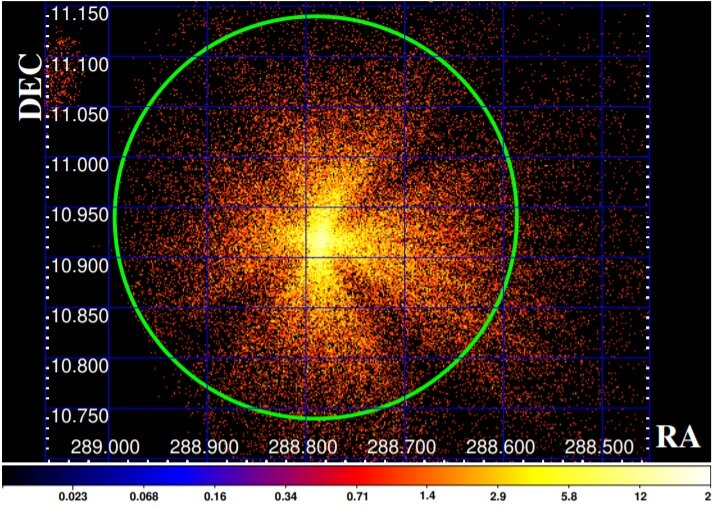| Manu | Date: Friday, 05-November-2021, 3:24 PM | Message # 1 |

--dragon lord--
Group: undead
Messages: 13977
Status: Offline
| Indian astronomers investigate X-ray binary GRS 1915+105
by Tomasz Nowakowski , Phys.org

AstroSat/SXT image of GRS 1915+105. Credit: Menon et al., 2021.
Using the AstroSat spacecraft, astronomers from India have observed an X-ray binary system known as GRS 1915+105. The satellite allowed the researchers to conduct a comprehensive study of this object, yielding essential information regarding its properties. Results of the research were published October 27 on arXiv.org.
X-ray binaries (XRBs) consist of a normal star or a white dwarf transferring mass onto a compact neutron star or a black hole. Many black hole XRBs show transient events that are characterized by outbursts in the X-ray band. Based on the mass of the companion star, astronomers divide XRBs into low-mass X-ray binaries (LMXBs) and high-mass X-ray binaries (HMXBs).
At a distance of some 28,000 light years away, GRS 1915+105 is a superluminal LMXB first detected during its outburst in August 1992. The system has an orbital period of 33.5 days and its black hole is estimated to be around 13 times more massive than the sun.
The source showcased a persistent brightness till mid-2018, when an exponential decrease in the X-ray flux was observed. This makes GRS 1915+105 one of the most remarkable LMXBs unlike other such objects which generally have long quiescence periods followed by an outburst lasting for months to a few years.
Previous observations of GRS 1915+105 have shown that it has displayed diverse variability in its light curve—it has exhibited 15 classes of variability so far. These classes could be structured down to transition between three states, namely: the quiescent state C, the outburst state B and the flare state A. In order to shed more light on this peculiar behavior of GRS 1915+105, a team of astronomers led by Athulya Menon of Dayananda Sagar University in India decided to investigate the source with AstroSat.
"In this paper, we perform an in-depth analysis of 31 AstroSat observations of GRS 1915+105 during the period of November 2016 to June 2019 by studying the broadband 'spectro-temporal' features of the source," the researchers wrote.
AstroSat observations confirmed that GRS 1915+105 exhibits various types of variability classes. Moreover, the results suggest possible transitions from one class to another via an unknown class within a few hours duration.
The astronomers noted that the X-ray intensity variations of GRS 1915+105 resembled the light curve of a "canonical" outbursting black hole, experiencing a slow-rise and slow-decay profile. However, it was found that this XRB does not follow the exemplary 'q'-diagram in the hardness-intensity diagram (HID), unlike canonical sources.
Furthermore, based on the AstroSat data, a gradual increase in the photon index from 1.83 to 3.8, disk temperature from 1.33 to 2.67 keV, and Quasi-periodic Oscillation (QPO) frequency from 4 to 5.64 Hz were found during the rise period. These parameters decrease to about 1.18, 1.18 keV, and 1.38 Hz, respectively, in the decline phase.
The study also found that GRS 1915+105 shows maximum bolometric luminosity during the peak at about 36 percent of Eddington luminosity, and a minimum of approximately 2.4 percent of Eddington luminosity during the decay phase. According to the authors of the paper, the behavior of GRS 1915+105 indicates that it will evolve towards an obscured low-luminosity (about 1 percent of Eddington luminosity) phase, with a decrease in the intrinsic bolometric luminosity of the source due to obscuration.

Read more/full article/source - https://phys.org/news/2021-11-indian-astronomers-x-ray-binary-grs.html
|
| |
| |















